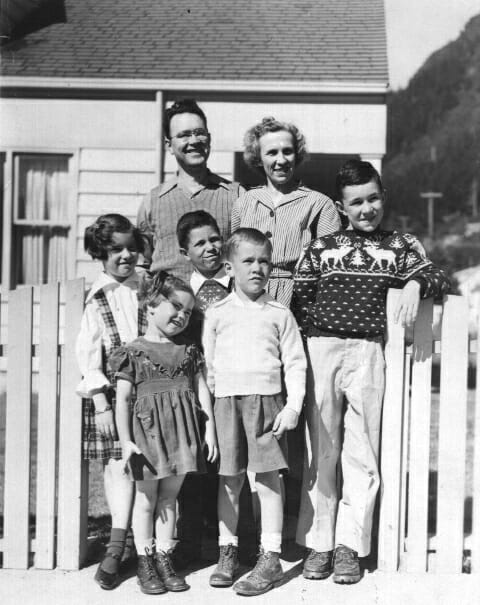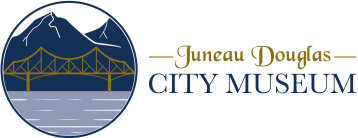Gastineau Channel Memories
Sundborg,George and Mary
George and Mary Sundborg
Our family lived in Juneau from 1938 to 1942, and again from 1946 to 1957. I went to Juneau in December of 1938. My wife, Mary, followed me in March of 1939, bringing the first of our family of five children. The children, all of whom grew up in Juneau, are Pierre, born in 1938, George Jr., born in 1940, Rosemary born in 1941, Stephen born in 1943 and Sarah born in 1944.
I was born in 1913, in San Francisco, and Mary was born in 1905, at Hoquiam, Washington. One of my father?s brothers, who had the same name as me, George Walter Sundborg, went to Alaska in the gold rush days and stayed for many years. My father, Charles Sundborg, spent a number of summers fishing at Bristol Bay before I ever went to Alaska. Neither Walt nor Charlie ever visited Juneau, so far as I know.
After Christmas of 1938, I sailed from Seattle on the steamer Baranof for Alaska to work on the Juneau Empire, where I was editorial writer and reporter on the federal and territorial beat. It was cold, raw and snowy when I got there. I lived for about two months in the Gastineau Hotel before Mary and Pierre arrived by steamer on a very stormy night. So stormy that the ship had trouble tying up to the dock. In the interim, the Territorial Legislature had met and I covered every session. I was the only newsman there. One morning I got up from my undisturbed slumbers and found the street in front of the hotel practically full of fire hoses. The Goldstein Building had burned down in the night just a little over a block away and I was probably the only person in Juneau who didn?t know it. You have all heard the Juneau fire horn, and I am sure none of you will ever forget its earthshaking blast. The brand new Baranof Hotel opened early in March of 1939, and I attended the big party at the opening.
We lived first in Juneau in a street level apartment in an old building on Main Street right where Front Street runs into it. It was obviously an old store which had been made over into an apartment. The Empire was owned by John W. Troy, who although a very sick man, was serving as Governor when I first arrived the fall of 1940. I had arranged to rent a house at Auke Bay from Dave Dishaw. It was quite isolated. I left each morning in the pitch dark by bus for Juneau and returned in equal blackness. The Dishaw house was later sold to Herb and Martha Wendling (she later became Mrs. Ralph Rivers) and we moved into town to an apartment in the Fosbee in the spring of 1941.
An unforgettable incident as a reporter in Juneau was when I served as an official witness at a hanging. An Indian, Nelson Charles, was executed upon conviction of first degree murder for killing his motherin-law in a particularly brutal and revolting way involving a broken beer bottle. Tradition seemed to require that the execution be performed at sunrise, which was very early at that time of year in Juneau. The deputy marshals had been rehearsing and planning the event for weeks, using a weighted dummy. He died instantly from all appearances. It was an upsetting thing to witness. Capital punishment in Alaska was abolished with statehood.
There would have been no particular hardship involved in having our sons and daughters born in Alaska, but there was a real problem in finding someone to care for the young children already in the family while a mother was in the hospital and coping with a new infant mmediately upon discharge. For this reason, the practical solution seemed to have Mary go home to Hoquiam each time a new child was about due. The trips back and forth on the steamers were both a great adventure and a great trial for Mary as she always had the contingent of small fry to keep in line. I remember that the Juneau Postmaster, a short tempered fellow named Albert White who made one trip back with Mary and Pierre, predicted to me that the boy was going to spend most of his career in jail because he was incorrigible.
I left the newspaper in July of 1941, and went to work on the staff of a newly opened Alaska regional office of the National Resources Planning Board. The war arrived suddenly in Alaska and I heard about it on the radio one Sunday in the Fosbee Apartments. Blackouts were being enforced all over the coastal areas. In Juneau, I was a member of a hastily assembled home guard which patrolled all parts of the city every night to be sure no light shone and no slinking enemy paddled ashore. We were armed with our own deer rifles. I was assigned to Willoughby Avenue and the Indian Village.
The Japanese bombed Dutch Harbor in June of 1942. A decision was made to move all military dependents out of Alaska and to transfer outside all government activities not necessarily located in the Territory. NRPB was one of the agencies relocated for the duration, the Alaska headquarters to be in Portland, Oregon. The family was ordered moved south by military transport.
I moved back to Alaska in September 1946, for the Alaska Development Board and traveled a great deal in the next six years. The family now fully staffed with five children did not move to Juneau until September of 1947 after I found a place to live. We moved into unbelievably small quarters in Juneau, a unit of the Channel Apartments.
Juneau is, of all the places we have lived, probably the city which has changed least through the years. This is partly because its physical setting is on a very grand scale, with Mts. Juneau and Roberts towering right out of Gastineau Channel on one side and the mountains of Douglas Island on the other. But one big change which had occurred between our first residence in Alaska (1938-1944) and our second (1946-1959), was that the Alaska Juneau Gold Mining Company had closed. Juneau was for many years a one-industry town. Even the fact the it was the territorial capital was secondary.
In March of 1949, we bought a large house on the corner of 9th and C Street and after having it expanded upwards so that it had a total of four bedrooms, moved in for the rest of our residence in Juneau.
The Alaska Development Board was under fire from many members of the Legislature and managed to have any appropriation for it eliminated from the budget. I then went on the staff of the Governor, and was paid an additional consultant?s fee of $200 a month to continue to direct operations of the Development Board. This arrangement was sanctioned by the Secretary of the Interior, Governor Gruening?s good friend. It is interesting that one charge leveled against me by a member of the Legislature was that I was wasting the taxpayers money by promoting of all the crazy things, drilling for oil in Alaska!
All those years I worked very closely with Ernest Gruening. He was a crusading Governor just as he had been a crusading newspaperman. The ultimate goal was statehood for Alaska and many of us worked relentlessly for it under his leadership. In 1952, I spent several months in Washington at the request of E.L. Bob Bartlett in trying to get an Alaska Statehood bill through Congress. We came close but not close enough. I drafted pro-statehood speeches which were given during the final floor debate by a dozen U.S. Senators. Governor Gruening was out of office in 1953, and so was I. President Eisenhower appointed B. Frank Heintzleman as Governor.
I then joined two other fellows, Jack McFarland and Jack Doyle in running a weekly newspaper, the Juneau Independent. I became deeply involved. First McFarland then Doyle pulled out. I felt a commitment to the some 3,000 subscribers who had paid in advance and couldn?t just quit. After four years, I succeeded in selling the paper and the building in which it was published. My salary through all of that period was $75 a week, but much of even that could not be paid until the end. Mary worked in the office at St. Ann?s Hospital so we could make ends meet. We lived very modestly.
One famous person we saw in Juneau in those days besides Adlai Stevenson was Edna Ferber. She arrived and called us from the Baranof Hotel. Bob Bartlett had given her our names. We soon gathered that she was writing a novel about Alaska, though she never said so. When my fortunes at the Independent were at lowest ebb and I was trying to refinance the venture, I received a letter from her enclosing an unsolicited check for $1,000. After I sold the paper and sent her the $1,000 plus interest at six per cent she returned it to me, explaining ?Dear George Sundborg, I never considered what I sent you to be an investment. It was a gift.? Her Alaska book Ice Palace was published in 1957. She died in 1967.
In 1955, the Legislature provided for an Alaska Constitutional Convention which would meet later that year and draw up a Constitution for the State-to-be, which still had not been authorized by Congress. I served as chairman of the Committee on Style and Drafting, which wrote in final form what has been described by political scientists as the finest state constitution ever adopted in the U.S. The convention was held at the University of Alaska near Fairbanks and I had my first experience with really bitter cold winter weather and the nightly aurora borealis. This position lasted from November 1955 to February 1956.
It was about a year after that that I sold the Independent. I went to Fairbanks in May 1957, to become editor of the Daily News-Miner. The family remained in Juneau until George finished high school the next year. When we moved to Fairbanks, Mary served as manager of the Fairbanks Medical and Surgical Clinic. In 1959, I moved to Washington, D.C., to serve as administrative assistant to Senator Gruening for ten years.
Our son Pierre returned to Juneau after attending California Institute of Technology. He had been valedictorian of the Juneau High School class of 1956. He married Jean Penrose, who was the home economics teacher at the high school. Pierre ran the Juneau Music Supply for Dick Garrison and had a regular program on radio station KINY. He began working at Juneau for IBM and served a whole career for that company at Seattle, White Plains, NY, and Fort Worth, Texas. He is now retired and living in Seattle.
Son George Jr., owns a heavy equipment servicing company at Fairbanks. Our youngest son Stephen is a Jesuit priest and president of Seattle University. Both of our daughters are medical doctors at Albuquerque, New Mexico, and Philadelphia, respectively.
We do not consider ourselves to be pioneer residents of Juneau, but we did live there for many years and loved the experience.
 |
Parents with (l to r): Rosemary, Sarah. George, Jr., Stephen and Pierre, 1949. |
